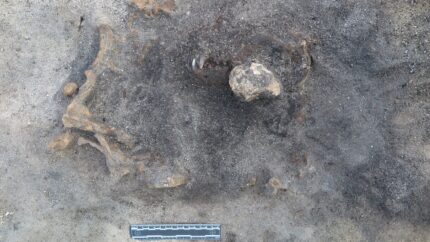The remains of a dog buried 8,400 years ago have been discovered in the Stone Age settlement at Ljungaviken, Sölvesborg. Objects found with it are believed to be grave goods, suggesting the dog was a beloved companion and colleague. It is one of the oldest dog finds ever made in Sweden, and the only one found in the middle of a Neolithic settlement.
The bones have been examined by an animal osteologist, but he was unable to identify its breed as there is no modern dog directly comparable. The closest he could get was to say that it was “like a powerful greyhound.”
“We hope to be able to lift the whole dog up in preparations, ie with soil and everything, and continue the investigations at Blekinge Museum’s object magazine.” says project manager Carl Persson at Blekinge museum.
“A find like this makes you feel even closer to the people who lived here,” he continues. “A buried dog somehow shows how similar we are over the millennia – the same feelings of loss and loss.”
When the settlement was inhabited (around 6,700-5,700 B.C.), the site was beachfront property on a small island or peninsula. The site was probably used only part of the year, in the summer and autumn, prime seasons for fishing and seal hunting. Paleobotanical finds indicate wild plants like melons and raspberries were foraged for food. Rising sea levels flooded the beach, covering the settlement with layers of wet sand and preserving it in good condition for thousands of years.
Archaeological surveys in 2015 discovered evidence of 56 different structures — hearths, postholes, pits — from the Stone Age and later materials from the Bronze and Iron Ages. The dog was buried among the Stone Age remains.

That is extraordinary! Hope to hear more when it is known.
It’s possible that empathy for animals is hardwired in some humans’ brains. So for them the orphaned baby wolf wasn’t something to eat but something to nurture.
From ITV News, 28 December 2018:
The [research] team found those who showed the greatest compassion for animals had a specific version of the oxytocin gene.
They also found women responded more positively towards animals than men, as did those working in a profession linked to animal care.
People’s attitudes towards animals are known to be influenced by a variety of social factors, such as early life experiences, personality traits and religious beliefs, researchers said.
According to the team, this is the first time scientists have shown that genetics may also play a role.
Dr Sarah Brown, from the Roslin Institute, said: “We already knew that oxytocin was important for empathy between people but now we know it helps us bond with animals too.”
Speaking as a canine professional, the skull is pretty obviously from a Molosser type. Molossers are commonly landrace breeds even today.